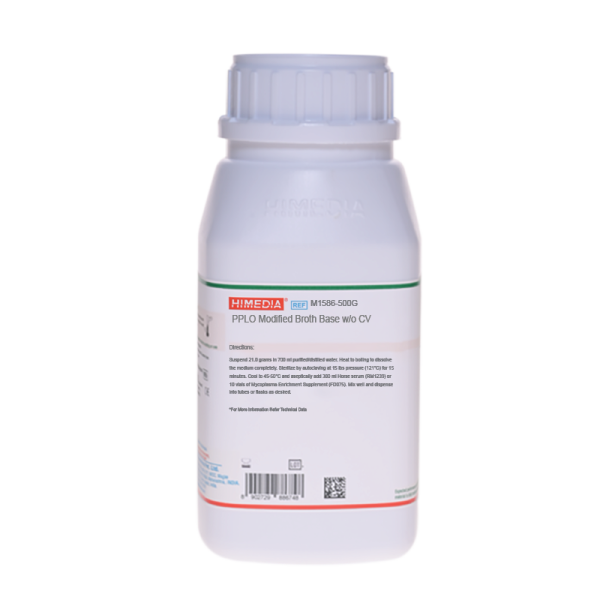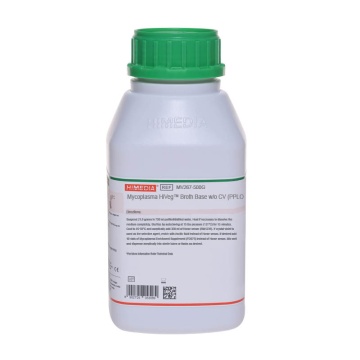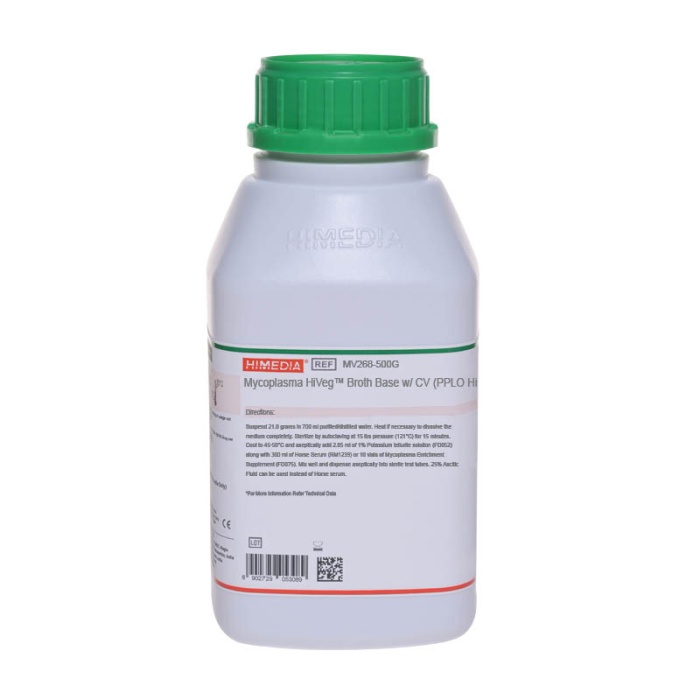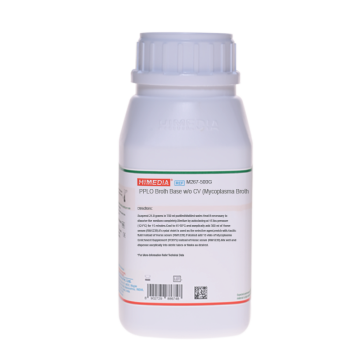 Your enquiry has been submitted
Your enquiry has been submitted
PPLO Modified Broth Base w/o CV
Intended Use
Recommended for isolation and cultivation of Mycoplasma (Pleuropneumonia like organisms).
Composition**
| Ingredients | g / L |
|---|---|
| HM infusion B from 50g # | 6.000 |
| Peptone | 10.000 |
| Sodium chloride | 5.000 |
Final pH ( at 25°C) 7.8±0.2
**Formula adjusted, standardized to suit performance parameters
# Equivalent to Meat infusion from
Directions
Suspend 21.0 grams in 700 ml purified / distilled water. Heat to boiling to dissolve the medium completely. Sterilize by autoclaving at 15 lbs pressure (121°C) for 15 minutes. Cool to 45-50°C and aseptically add 300 ml Horse serum (RM1239) or 10 vials of HPYT Enrichment Supplement (FD075). Mix well and dispense into tubes or flasks as desired.
Principle And Interpretation
PPLO Agar was described by Morton, Smith and Leberman (1). It was used in a study of the growth requirements of Mycoplasma (2), along with the identification and cultivation of this organism. (3-5). Pivotal information regarding Mycoplasma has been documented by Sabin (6). Hayflick et al have reported the information regarding the cultivation of Mycoplasma (7).
PPLO Broth without crystal violet is prepared according to the formula described by Morton and Lecce (2). Crystal violet is omitted from this formula due to its inhibitory action on some Mycoplasma. It has been used for the cultivation of Mycoplasma for research studies (8,9).
For the cultivation of Mycoplasma the medium ingredients and all the supplements should be free of any toxic substances even in small amounts. Many Mycoplasma require serum for their good growth and also presence of antibiotic is necessary to prevent the growth of contaminating organisms. Mostly the Mycoplasma species are aerobic or facultatively anaerobic but some are microaerophilic. Few are anaerobic saprophytic Mycoplasma which grow best at 22-35°C while pathogenic strains grow at 35°C.
Tubes should be incubated in an atmosphere containing 5-10% carbon dioxide and examined after incubation of 48 hours but they should not be discarded as negative until after incubation for 3 weeks.
Type of specimen
Clinical samples
Specimen Collection and Handling
For clinical samples follow appropriate techniques for handling specimens as per established guidelines (10,11). After use, contaminated materials must be sterilized by autoclaving before discarding.
Warning and Precautions
In Vitro diagnostic Use only. For professional use only. Read the label before opening the container. Wear protective gloves/protective clothing/eye protection/ face protection. Follow good microbiological lab practices while handling specimens and culture. Standard precautions as per established guidelines should be followed while handling clinical specimens. Safety guidelines may be referred in individual safety data sheets.
Limitations
- Since Mycoplasma species are aerobic or facultatively anaerobic but some are micro aerophilic, proper incubation should be carried out for optimal recovery.
- Few are anaerobic saprophytic Mycoplasma which grow best at 22-35°C while pathogenic strains grow at 35°C, hence growth conditions must be maintained.
- Since the medium is highly enriched care must be taken during inoculation to avoid contamination.
Performance and Evaluation
Performance of the medium is expected when used as per the direction on the label within the expiry period when stored at recommended temperature.
Quality Control
Appearance: Cream to yellow homogeneous free flowing powder
Colour and Clarity of prepared medium: Yellow coloured clear solution in tubes
Reaction: Reaction of 2.1% w/v aqueous solution at 25°C. pH : 7.8±0.2
pH: 7.60-8.00
Cultural Response: Cultural characteristics observed in presence of 10% CO2 with added Horse serum (RM1239) OR 10 vials of HPYT Enrichment Supplement (FD075), after an incubation at 22-35°C for 24-48 hours
| Organism | Growth |
|---|---|
| Mycoplasma bovis ATCC 25523 | good-luxuriant |
| Mycoplasma gallinarium ATCC 19708 | good-luxuriant |
| Mycoplasma pneumoniae ATCC 15531 | good-luxuriant |
| Streptococcus pneumoniae ATCC 6303 | good-luxuriant |
Storage and Shelf Life
Store below 10-30°C in a tightly closed container and the prepared medium at 2-8°C. Use before expiry date on the label. On opening, product should be properly stored dry, after tightly capping the bottle in order to prevent lump formation due to the hygroscopic nature of the product. Improper storage of the product may lead to lump formation. Store in dry ventilated area protected from extremes of temperature and sources of ignition Seal the container tightly after use. Product performance is best if used within stated expiry period.
Disposal
User must ensure safe disposal by autoclaving and/or incineration of used or unusable preparations of this product. Follow established laboratory procedures in disposing of infectious materials and material that comes into contact with clinical sample must be decontaminated and disposed of in accordance with current laboratory techniques (10,11).
Reference
- Morton, Smith and Leberman, 1951, Am. J. Syphilis Gonorrh. Veneral Diseases, 35: 361.
- Morton and Lecce, 1953. J. Bacteriol., 66:646.
- Chanock, James, Fox, Turner, Mufso and Hayflick, 1962, Soc. Exp. Biol. Med., 110:884.
- Craven, Wenzel, Calhoun, Hendley, Hamory and Gwaltney, 1976, J. Clin. Microbiol., 4:225.
- Gregory and Cundy, 1970, Appl. Microbiol., 19:268.
- Sabin, 1941, Bacteriol. Rev., 5:1, 331.
- Hayflick and Chanock, 1965, Bacteriol, Rev., 29:185.
- Adler and Da Massa, 1967, Appl. Microbiol., 15:245.
- Leland, Lapworth, Jones and French, 1982, J. Clin. Microbiol., 16:709.
- Isenberg, H.D. Clinical Microbiology Procedures Handbook 2nd Edition
- Jorgensen, J.H., Pfaller , M.A., Carroll, K.C., Funke, G., Landry, M.L., Richter, S.S and Warnock., D.W. (2015) Manual Clinical Microbiology, 11th Edition. Vol. 1.
| Product Name | PPLO Modified Broth Base w/o CV |
|---|---|
| SKU | M1586 |
| Product Type | Regular |
| Physical Form | Powder |
| Origin | Animal |
| Packaging type | HDPE |
| References | 1. Morton, Smith and Leberman, 1951, Am. J. Syphilis Gonorrh. Veneral Diseases, 35: 361. |
| Customized Product Available | No |











